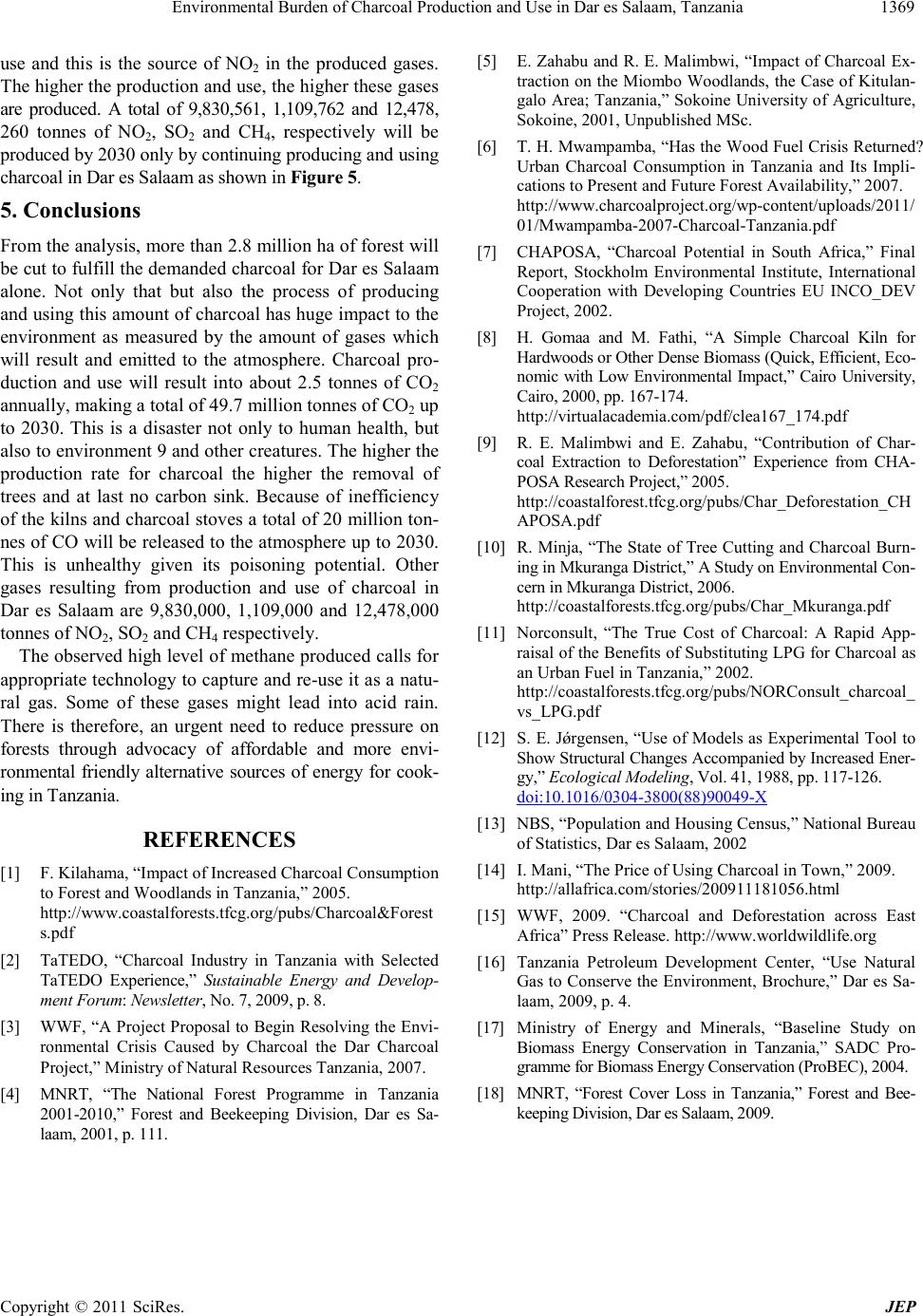
Environmental Burden of Charcoal Production and Use in Dar es Salaam, Tanzania
Copyright © 2011 SciRes. JEP
1369
use and this is the source of NO2 in the produced gases.
The higher the production and use, the higher these gases
are produced. A total of 9,830,561, 1,109,762 and 12,478,
260 tonnes of NO2, SO2 and CH4, respectively will be
produced by 2030 only by continuing producing and using
charcoal in Dar es Salaam as shown in Figure 5.
5. Conclusions
From the analysis, more than 2.8 million ha of forest will
be cut to fulfill the demanded charcoal for Dar es Salaam
alone. Not only that but also the process of producing
and using this amount of charcoal has huge impact to the
environment as measured by the amount of gases which
will result and emitted to the atmosphere. Charcoal pro-
duction and use will result into about 2.5 tonnes of CO2
annually, making a total of 49.7 million tonnes of CO2 up
to 2030. This is a disaster not only to human health, but
also to environment 9 and other creatures. The higher the
production rate for charcoal the higher the removal of
trees and at last no carbon sink. Because of inefficiency
of the kilns and charcoal stoves a total of 20 million ton-
nes of CO will be released to the atmosphere up to 2030.
This is unhealthy given its poisoning potential. Other
gases resulting from production and use of charcoal in
Dar es Salaam are 9,830,000, 1,109,000 and 12,478,000
tonnes of NO2, SO2 and CH4 respectively.
The observed high level of methane produced calls for
appropriate technology to capture and re-use it as a natu-
ral gas. Some of these gases might lead into acid rain.
There is therefore, an urgent need to reduce pressure on
forests through advocacy of affordable and more envi-
ronmental friendly alternative sources of energy for cook-
ing in Tanzania.
REFERENCES
[1] F. Kilahama, “Impact of Increased Charcoal Consumption
to Forest and Woodlands in Tanzania,” 2005.
http ://www.coastal forests.tfcg. org /pub s/Charco al&Fo rest
s.pdf
[2] TaTEDO, “Charcoal Industry in Tanzania with Selected
TaTEDO Experience,” Sustainable Energy and Develop-
ment Forum: Newsletter, No. 7, 2009, p. 8.
[3] WWF, “A Project Proposal to Begin Resolving the Envi-
ronmental Crisis Caused by Charcoal the Dar Charcoal
Project,” Ministry of Natural Resources Tanzania, 2007.
[4] MNRT, “The National Forest Programme in Tanzania
2001-2010,” Forest and Beekeeping Division, Dar es Sa-
laam, 2001, p. 111.
[5] E. Zahabu and R. E. Malimbwi, “Impact of Charcoal Ex-
traction on the Miombo Woodlands, the Case of Kitulan-
galo Area; Tanzania,” Sokoine University of Agriculture,
Sokoine, 2001, Unpublished MSc.
[6] T. H. Mwampamba, “Has the Wood Fuel Crisis Returned?
Urban Charcoal Consumption in Tanzania and Its Impli-
cations to Present and Future Forest Availability,” 2007.
http://www.charcoalproject.org/wp-content/uploads/2011/
01/Mwampamba-2007-Charcoal-Tanzania.pdf
[7] CHAPOSA, “Charcoal Potential in South Africa,” Final
Report, Stockholm Environmental Institute, International
Cooperation with Developing Countries EU INCO_DEV
Project, 2002.
[8] H. Gomaa and M. Fathi, “A Simple Charcoal Kiln for
Hardwoods or Other Dense Biomass (Quick, Efficient, Eco-
nomic with Low Environmental Impact,” Cairo University,
Cairo, 2000, pp. 167-174.
http ://virtu alacad emia.co m/pdf/cl ea167_174.pdf
[9] R. E. Malimbwi and E. Zahabu, “Contribution of Char-
coal Extraction to Deforestation” Experience from CHA-
POSA Research Project,” 2005.
http://coastalforest.tfcg.org/pubs/Char_Deforestation_CH
APOSA.pdf
[10] R. Minja, “The State of Tree Cutting and Charcoal Burn-
ing in Mkuranga District,” A Study on Environmental Con-
cern in Mkuranga District, 2006.
http://coastalforests.tfcg.org/pubs/Char_Mkuranga.pdf
[11] Norconsult, “The True Cost of Charcoal: A Rapid App-
raisal of the Benefits of Substituting LPG for Charcoal as
an Urban Fuel in Tanzania,” 2002.
http://coastalforests.tfcg.org/pubs/NORConsult_charcoal_
vs_LPG.pdf
[12] S. E. Jǿrgensen, “Use of Models as Experimental Tool to
Show Structural Changes Accompanied by Increased Ener-
gy,” Ecological Modeling, Vol. 41, 1988, pp. 117-126.
do i:1 0.10 16 /03 04 -38 00( 88) 90 049- X
[13] NBS, “Population and Housing Census,” National Bureau
of Statistics, Dar es Salaam, 2002
[14] I. Mani, “The Price of Using Charcoal in Town,” 2009.
http://allafrica.com/stories/200911181056.html
[15] WWF, 2009. “Charcoal and Deforestation across East
Africa” Press Release. http://www.worldwildlife.org
[16] Tanzania Petroleum Development Center, “Use Natural
Gas to Conserve the Environment, Brochure,” Dar es Sa-
laam, 2009, p. 4.
[17] Ministry of Energy and Minerals, “Baseline Study on
Biomass Energy Conservation in Tanzania,” SADC Pro-
gramme for Biomass Energy Conservation (ProBEC), 2004.
[18] MNRT, “Forest Cover Loss in Tanzania,” Forest and Bee-
keeping Division, Dar es Salaam, 2009.